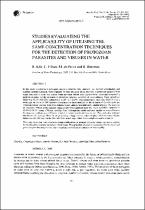 ResearchSpace
ResearchSpace
Studies evaluating the applicability of utilizing the same concentration techniques for the detection of protozoan parasites and viruses in water
JavaScript is disabled for your browser. Some features of this site may not work without it.
- ResearchSpace
- →
- Research Publications/Outputs
- →
- Journal Articles
- →
- View Item
| dc.contributor.author |
Kfir, R

|
|
| dc.contributor.author |
Hilner, C

|
|
| dc.contributor.author |
Du Preez, M

|
|
| dc.contributor.author |
Bateman, B

|
|
| dc.date.accessioned | 2007-06-12T08:11:34Z | |
| dc.date.available | 2007-06-12T08:11:34Z | |
| dc.date.issued | 1995 | |
| dc.identifier.citation | Kfir, R, et al. 1995. Studies evaluating the applicability of utilizing the same concentration techniques for the detection of protozoan parasites and viruses in water. Water Science and Technology, vol. 31, 06 May, pp 417-423 | en |
| dc.identifier.issn | 0273-1223 | |
| dc.identifier.uri | http://hdl.handle.net/10204/596 | |
| dc.description | Copyright: 1995 Pergamon-Elsevier Science Ltd | en |
| dc.description.abstract | In this study concentration techniques regularly used for viral detection; i.e. flat-bed ultra-filtration and filterite cartridge filtration, were evaluated for their efficacies in the recovery of protozoan parasites from water. Recovery of cysts was studied using tap water seeded with Giardia muris cysts and compared to methods designed for the detection of protozoan parasites. Recovery of cysts utilizing 1.2 mu m membrane filters was 11.1% (4.5-23%) compared to 11.6% (2.7-25.5%) with ultra-filtration (pore size 46-50 Angstrom, with a molecular cut off of 50 000 Daltons). Comparison of these methods for the isolation of Giardia cysts and Cryptosporidium oocysts from environmental water samples also indicated a similar efficacy. The recovery of cysts from 1001 of seeded samples using a Cuno wynd cartridge filter was 12.2% (1.6-45%) compared to 13.4% (5-24.2%) using a Filterite cartridge filter. Although the results indicated similar recovery efficacies for these two methods, use of Filterite resulted in a more consistent recovery rate. This study also indicated that the use of cartridge filters for the processing of large volume water samples (1001) showed a slightly better recovery efficacy than the flat-bed filtration technique which limits sample volume to about 101. This study shows that concentration techniques utilised for the isolation of enteric viruses can also be applied for the detection of protozoan parasites from water. This procedure allows for co-analysis of both viruses and protozoan parasites and provides a more rapid and cost-effective evaluation of water quality. | en |
| dc.language.iso | en | en |
| dc.publisher | Pergamon-Elsevier Science Ltd | en |
| dc.subject | Giardia | en |
| dc.subject | Cryptosporidium | en |
| dc.subject | Enteric viruses | en |
| dc.subject | Flat bed filtration | en |
| dc.subject | Cartridge filter | en |
| dc.subject | Ultra-filtration | en |
| dc.title | Studies evaluating the applicability of utilizing the same concentration techniques for the detection of protozoan parasites and viruses in water | en |
| dc.type | Article | en |
| dc.identifier.apacitation | Kfir, R., Hilner, C., Du Preez, M., & Bateman, B. (1995). Studies evaluating the applicability of utilizing the same concentration techniques for the detection of protozoan parasites and viruses in water. http://hdl.handle.net/10204/596 | en_ZA |
| dc.identifier.chicagocitation | Kfir, R, C Hilner, M Du Preez, and B Bateman "Studies evaluating the applicability of utilizing the same concentration techniques for the detection of protozoan parasites and viruses in water." (1995) http://hdl.handle.net/10204/596 | en_ZA |
| dc.identifier.vancouvercitation | Kfir R, Hilner C, Du Preez M, Bateman B. Studies evaluating the applicability of utilizing the same concentration techniques for the detection of protozoan parasites and viruses in water. 1995; http://hdl.handle.net/10204/596. | en_ZA |
| dc.identifier.ris | TY - Article AU - Kfir, R AU - Hilner, C AU - Du Preez, M AU - Bateman, B AB - In this study concentration techniques regularly used for viral detection; i.e. flat-bed ultra-filtration and filterite cartridge filtration, were evaluated for their efficacies in the recovery of protozoan parasites from water. Recovery of cysts was studied using tap water seeded with Giardia muris cysts and compared to methods designed for the detection of protozoan parasites. Recovery of cysts utilizing 1.2 mu m membrane filters was 11.1% (4.5-23%) compared to 11.6% (2.7-25.5%) with ultra-filtration (pore size 46-50 Angstrom, with a molecular cut off of 50 000 Daltons). Comparison of these methods for the isolation of Giardia cysts and Cryptosporidium oocysts from environmental water samples also indicated a similar efficacy. The recovery of cysts from 1001 of seeded samples using a Cuno wynd cartridge filter was 12.2% (1.6-45%) compared to 13.4% (5-24.2%) using a Filterite cartridge filter. Although the results indicated similar recovery efficacies for these two methods, use of Filterite resulted in a more consistent recovery rate. This study also indicated that the use of cartridge filters for the processing of large volume water samples (1001) showed a slightly better recovery efficacy than the flat-bed filtration technique which limits sample volume to about 101. This study shows that concentration techniques utilised for the isolation of enteric viruses can also be applied for the detection of protozoan parasites from water. This procedure allows for co-analysis of both viruses and protozoan parasites and provides a more rapid and cost-effective evaluation of water quality. DA - 1995 DB - ResearchSpace DP - CSIR KW - Giardia KW - Cryptosporidium KW - Enteric viruses KW - Flat bed filtration KW - Cartridge filter KW - Ultra-filtration LK - https://researchspace.csir.co.za PY - 1995 SM - 0273-1223 T1 - Studies evaluating the applicability of utilizing the same concentration techniques for the detection of protozoan parasites and viruses in water TI - Studies evaluating the applicability of utilizing the same concentration techniques for the detection of protozoan parasites and viruses in water UR - http://hdl.handle.net/10204/596 ER - | en_ZA |





